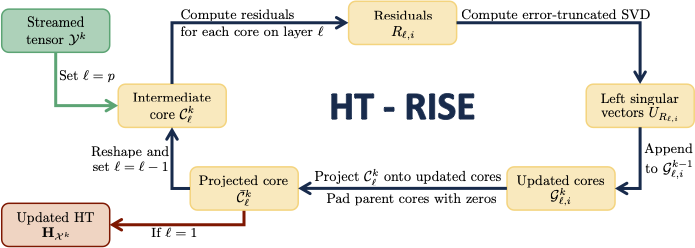publications
publications by categories in reversed chronological order. generated by jekyll-scholar.
2024
- Incremental Hierarchical Tucker DecompositionDoruk Aksoy, and Alex A. Gorodetsky2024
We present two new algorithms for approximating and updating the hierarchical Tucker decomposition of tensor streams. The first algorithm, Batch Hierarchical Tucker - leaf to root (BHT-l2r), proposes an alternative and more efficient way of approximating a batch of similar tensors in hierarchical Tucker format. The second algorithm, Hierarchical Tucker - Rapid Incremental Subspace Expansion (HT-RISE), updates the batch hierarchical Tucker representation of an accumulated tensor as new batches of tensors become available. The HT-RISE algorithm is suitable for the online setting and never requires full storage or reconstruction of all data while providing a solution to the incremental Tucker decomposition problem. We provide theoretical guarantees for both algorithms and demonstrate their effectiveness on physical and cyber-physical data. The proposed BHT-l2r algorithm and the batch hierarchical Tucker format offers up to 6.2× compression and 3.7× reduction in time over the hierarchical Tucker format. The proposed HT-RISE algorithm also offers up to 3.1× compression and 3.2× reduction in time over a state of the art incremental tensor train decomposition algorithm.
@misc{aksoy2024incrementalht, title = {Incremental Hierarchical Tucker Decomposition}, author = {Aksoy, Doruk and Gorodetsky, Alex A.}, year = {2024}, eprint = {2412.16544}, archiveprefix = {arXiv}, primaryclass = {math.NA}, url = {https://arxiv.org/abs/2412.16544}, } - SISC
 An incremental tensor train decomposition algorithmDoruk Aksoy, David J Gorsich, Shravan Veerapaneni, and 1 more authorSIAM Journal on Scientific Computing, 2024
An incremental tensor train decomposition algorithmDoruk Aksoy, David J Gorsich, Shravan Veerapaneni, and 1 more authorSIAM Journal on Scientific Computing, 2024We present a new algorithm for incrementally updating the tensor train decomposition of a stream of tensor data. This new algorithm, called the tensor train incremental core expansion (TT-ICE), improves upon the current state-of-the-art algorithms for compressing in tensor train format by developing a new adaptive approach that incurs significantly slower rank growth and guarantees compression accuracy. This capability is achieved by limiting the number of new vectors appended to the TT-cores of an existing accumulation tensor after each data increment. These vectors represent directions orthogonal to the span of existing cores and are limited to those needed to represent a newly arrived tensor to a target accuracy. We provide two versions of the algorithm: TT-ICE and TT-ICE accelerated with heuristics (TT-ICE). We provide a proof of correctness for TT-ICE and empirically demonstrate the performance of the algorithms in compressing large-scale video and scientific simulation datasets. Compared to existing approaches that also use rank adaptation, TT-ICE achieves higher compression and up to reduction in computational time.
@article{aksoy2024incremental, title = {An incremental tensor train decomposition algorithm}, author = {Aksoy, Doruk and Gorsich, David J and Veerapaneni, Shravan and Gorodetsky, Alex A}, journal = {SIAM Journal on Scientific Computing}, volume = {46}, number = {2}, pages = {A1047--A1075}, doi = {10.1137/22M1537734}, year = {2024}, publisher = {SIAM}, } - IEPC2024
 Compressed Analysis of Electric Propulsion Simulations using Low Rank Tensor NetworksDoruk Aksoy, Sruti Vutukury, Thomas A Marks, and 2 more authors2024
Compressed Analysis of Electric Propulsion Simulations using Low Rank Tensor NetworksDoruk Aksoy, Sruti Vutukury, Thomas A Marks, and 2 more authors2024This work presents an approach to mitigate high storage and computational costs associated with analysis of high-fidelity simulation data. Specifically, we demonstrate that low-rank tensor compression of field quantities from particle-based plasma simulation data of electric propulsion devices can yield significant benefits. Moreover, compression in lowrank tensor format enables doing typical analysis without decompression. Our test-case is a 3D simulation of an SPT-100 thruster operating in vacuum using AFRL’s Thermophysics Universal Research Framework (TURF) code. We measure the TT-ICE method’s performance on the simulation data based on compression ratio, compression time, and integrity of the reconstructed dataset to the original. For particle number densities stored in structured meshes, we achieve a compression ratio (CR) of 8.08×. For ion current density and electric field components, we achieve a CR of 6.23× and 354, 796×, respectively. For unstructured surface mesh data, we see near exact floating potential approximations and derived total current to surface quantities.
@article{aksoy2024compressed, title = {Compressed Analysis of Electric Propulsion Simulations using Low Rank Tensor Networks}, author = {Aksoy, Doruk and Vutukury, Sruti and Marks, Thomas A and Eckels, Joshua D and Gorodetsky, Alex A}, year = {2024}, } - IEPC2024
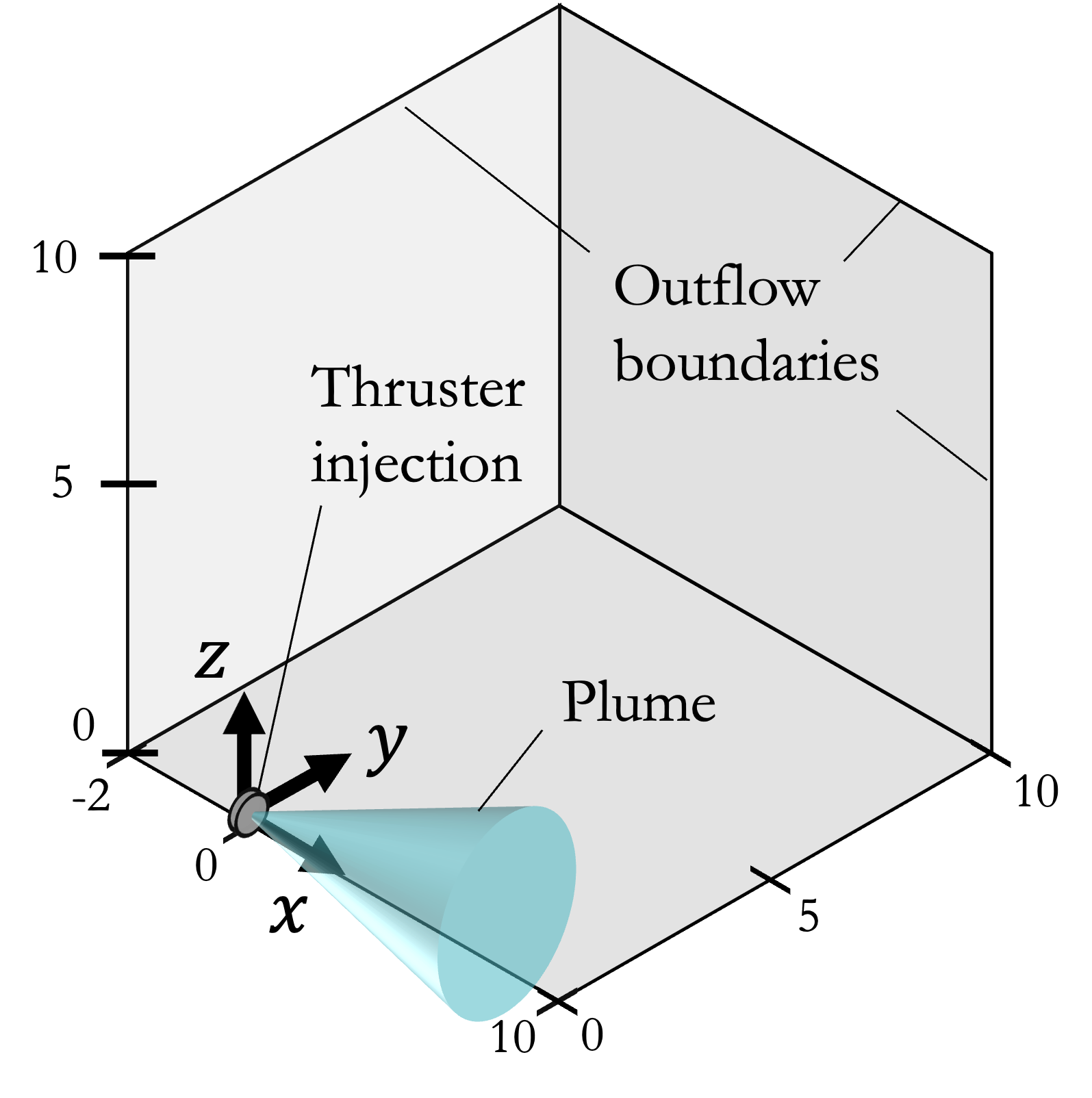 Dynamic mode decomposition for particle-in-cell simulations of a Hall thruster and plumeJoshua D Eckels, Thomas A Marks, Doruk Aksoy, and 2 more authors2024
Dynamic mode decomposition for particle-in-cell simulations of a Hall thruster and plumeJoshua D Eckels, Thomas A Marks, Doruk Aksoy, and 2 more authors2024In this work, we target the acceleration of particle-in-cell (PIC) methods for Hall thrusters by way of data-driven reduced-order modeling through the dynamic mode decomposition (DMD). The primary goal of data-driven reduced-order modeling is to learn a system’s dynamics from observations of its state over time. Once obtained, the reducedorder model can be used in place of the original system for cheap forecasting of its state. In this work, we build reduced-order models for the dynamics of kinetic PIC simulations of a Hall thruster plasma. Specifically, we apply the linear DMD approximation to a fully-kinetic simulation of a Hall thruster discharge channel and separately to a 3d hybrid fluid/PIC simulation of a Hall thruster plume. We found that a rank-truncated linear fit is sufficient to qualitatively, and sometimes quantitatively, predict the primary modes of the plasma dynamics, including the azimuthal wave propagations in the discharge channel that are indicative of the electron drift instability. We also observed that high noise, highdimensional, and multi-scale behavior presents a computational challenge for efficiently and accurately fitting PIC simulations. With further refinement, we envision that “kinetic” reduced-order models of a Hall thruster have potential use in downstream applications such as online control and closure modeling.
@article{eckels2024dynamic, title = {Dynamic mode decomposition for particle-in-cell simulations of a Hall thruster and plume}, author = {Eckels, Joshua D and Marks, Thomas A and Aksoy, Doruk and Vutukury, Sruti and Gorodetsky, Alex A}, year = {2024}, } - TMLR
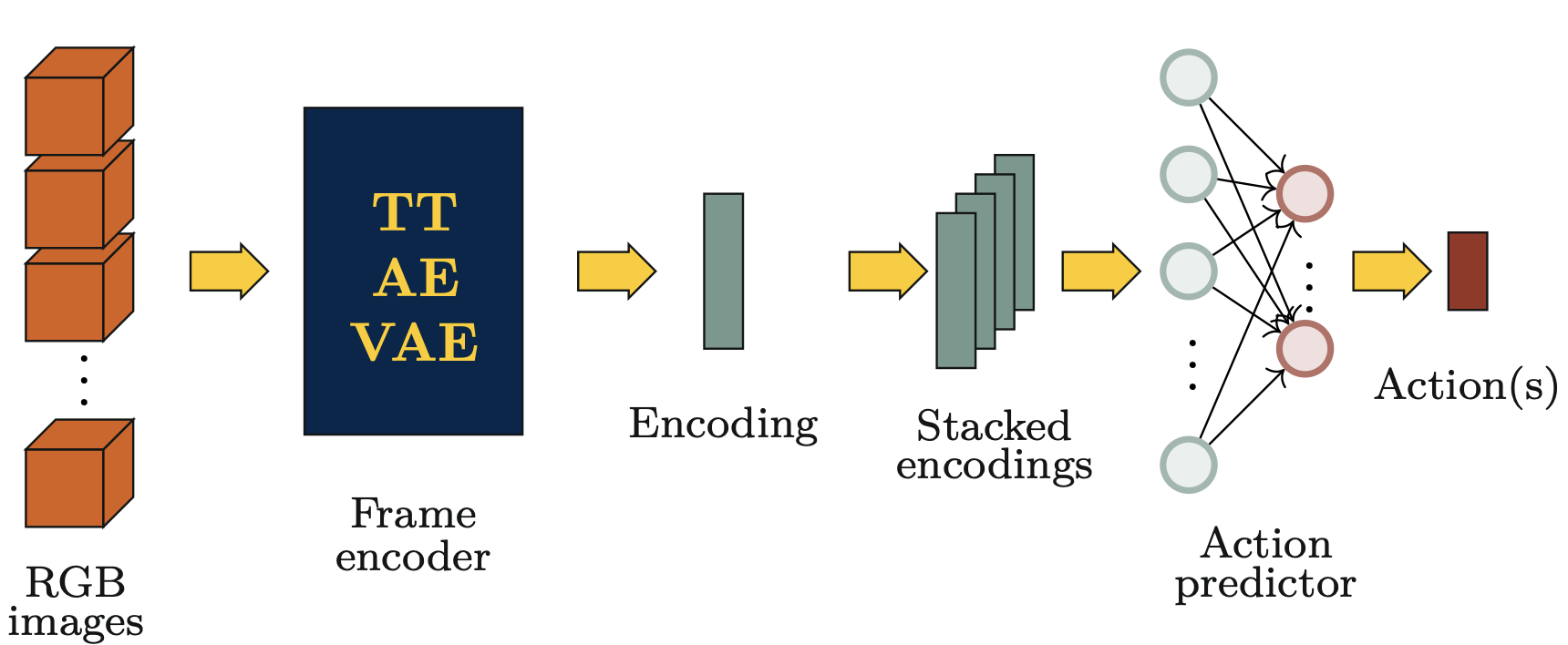 Low-Rank Tensor-Network Encodings for Video-to-Action Behavioral CloningBrian Chen*, Doruk Aksoy*, David J Gorsich, and 2 more authorsTransactions on Machine Learning Research, 2024
Low-Rank Tensor-Network Encodings for Video-to-Action Behavioral CloningBrian Chen*, Doruk Aksoy*, David J Gorsich, and 2 more authorsTransactions on Machine Learning Research, 2024We describe a tensor-network latent-space encoding approach for increasing the scalability of behavioral cloning of a video game player’s actions entirely from video streams of the gameplay. Specifically, we address challenges associated with the high computational requirements of traditional deep-learning based encoders such as convolutional variational autoencoders that prohibit their use in widely available hardware or for large scale data. Our approach uses tensor networks instead of deep variational autoencoders for this purpose, and it yields significant speedups with no loss of accuracy. Empirical results on ATARI games demonstrate that our approach leads to a speedup in the time it takes to encode data and train a predictor using the encodings (between 2.6× to 9.6× compared to autoencoders or variational autoencoders). Furthermore, the tensor train encoding can be efficiently trained on CPU as well, which leads to comparable or better training times than the autoencoder and variational autoencoder trained on GPU (0.9× to 5.4× faster). These results suggest significant possibilities in mitigating the need for cost and time-intensive hardware for training deep-learning architectures for behavioral cloning.
@article{chen2024lowrank, title = {Low-Rank Tensor-Network Encodings for Video-to-Action Behavioral Cloning}, author = {Chen, Brian and Aksoy, Doruk and Gorsich, David J and Veerapaneni, Shravan and Gorodetsky, Alex}, journal = {Transactions on Machine Learning Research}, issn = {2835-8856}, year = {2024}, url = {https://openreview.net/forum?id=w4DXLzBPPw}, note = {}, }
2022
- NC&A
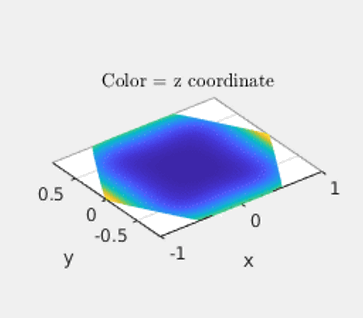 Inverse design of self-oscillatory gels through deep learningDoruk Aksoy, Silas Alben, Robert D Deegan, and 1 more authorNeural Computing and Applications, 2022
Inverse design of self-oscillatory gels through deep learningDoruk Aksoy, Silas Alben, Robert D Deegan, and 1 more authorNeural Computing and Applications, 2022We develop a deep learning architecture for inverse design of a self-oscillating sheet propelled by an embedded chemical reaction. The dynamics of our prob- lems are nonlinear and exhibit chaotic behavior, a chal- lenging setting for existing deep-learning-based inverse design approaches. The aim is to explore data-driven design of soft robots using a novel locomotion mecha- nism. We train the architecture using a forward model of the locomotion mechanism developed recently by Al- ben et. al (2019). The architecture is shown to success- fully map a snapshot of target motions of the gel into geometric and reaction parameters. The final architec- ture consists of a Multi-layer Perceptron (MLP) classi- fier for discrete parameters followed by a stacked MLP regressor (SMLPR) for continuous parameters.Our in- verse design setting is unique in that it considers both discrete and continuous outputs, requiring an architec- ture capable of classification and regression. We are able to recover parameters within 2.87% accuracy. We also compare the simulated motion of the sheets at the re- covered parameters. Because the motion has a chaotic quality, our demonstration is able to show quantita- tive agreement for a small time horizon and qualitative agreement over longer time horizons. We also demon- strate agreement of Lyapunov exponents up to 6.78% accuracy for suitable motions.
@article{aksoy2022inverse, title = {Inverse design of self-oscillatory gels through deep learning}, author = {Aksoy, Doruk and Alben, Silas and Deegan, Robert D and Gorodetsky, Alex A}, journal = {Neural Computing and Applications}, volume = {34}, number = {9}, pages = {6879--6905}, year = {2022}, publisher = {Springer}, }
2020
- ACC2020
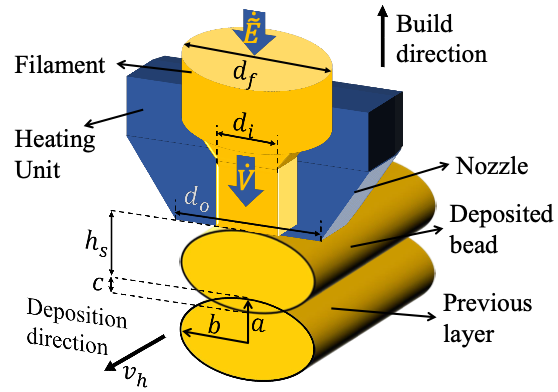 A control-oriented model for bead cross-sectional geometry in fused deposition modelingDoruk Aksoy, Efe C Balta, Dawn M Tilbury, and 1 more authorIn 2020 American Control Conference (ACC), 2020
A control-oriented model for bead cross-sectional geometry in fused deposition modelingDoruk Aksoy, Efe C Balta, Dawn M Tilbury, and 1 more authorIn 2020 American Control Conference (ACC), 2020Additive manufacturing (AM) is a digital man- ufacturing technology that manufactures a 3D object in a bottom-up and layer-by-layer fashion. Fused deposition mod- eling (FDM), also known as desktop 3D printing, is one of the most commonly used AM technologies with numerous applications in academia and industry. Some of the greatest challenges with FDM include poor repeatability and reliability of the process, leading to mid-process failures or out-of-spec final products. Closed-loop control applications for FDM have been proposed as a means of mitigating mid-process failures. However, no models currently exist to enable control of the bead cross-sectional dimensions for the extruded material. This work presents a control-oriented model describing the effect of process parameters on cross-sectional dimensions of the deposited beads in FDM. A geometric model is presented and a procedure to evaluate the unknown machine and material specific parameters in the model is provided by leveraging design of experiments. The proposed model is experimentally validated and the accuracy of the results is presented. The results show that the proposed model accurately represents the bead cross-sectional geometry and is suitable for closed-loop control applications.
@inproceedings{aksoy2020control, title = {A control-oriented model for bead cross-sectional geometry in fused deposition modeling}, author = {Aksoy, Doruk and Balta, Efe C and Tilbury, Dawn M and Barton, Kira}, booktitle = {2020 American Control Conference (ACC)}, pages = {474--480}, year = {2020}, organization = {IEEE}, }
